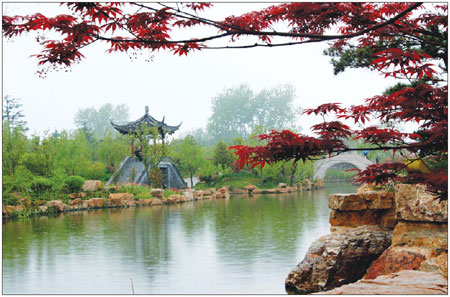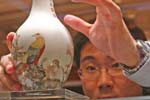Gardens of glory
Updated: 2011-04-08 12:18
By Yan Yiqi (China Daily European Weekly)
Yangzhou is the beautiful southern gateway of Jiangsu province
Wondering where to visit in China during April? Why not choose Yangzhou, historically one of wealthiest of China's cities and home to some of the tastiest cuisine in the land. Located in the central part of East China's Jiangsu province, Yangzhou has a history of 2,500 years and the oldest section of China's Grand Canal still remains. The city, covering an area of 6,634 sq km, is a living museum of Chinese culture and is also dotted with beautiful gardens. It will never disappoint the curious tourist in spring.
 |
|
Slender West Lake is a very scenic attraction for Yangzhou visitors. |
Small and quiet as it is, visitors can have easy access to all latest modern convenience in Yangzhou, too, while enjoying traditional heritage.
Throughout the ages, scholars and poets have lavishly praised Yangzhou in prose and poetry, including one of the greatest of them all, Li Bai.
And the city's famous flower, the qiong hua, blooms with special beauty during April. It is a symbol of the city and this eight-petal flower is rarely seen outside the region.
Mid-April is a magic time in this city of 5 million people.
The white-flower trees blossom and their scent mixes in the air, offering a sense of relaxation.
Modern day Yangzhou is famous for its stuffed toys. With cheap labor and materials, Yangzhou's stuffed toys are cheaper and are of better quality than other cities.
Remember to buy some toys when you visit Yangzhou. Check out these five scenic spots:
1. Slender West Lake
Named after Hangzhou's West Lake, this long, narrow stretch of water is a must-see on your Yangzhou holiday.
The lake is situated in the northwest of Yangzhou city and its 4.3-kilometer banks sprout with weeping willows.
At the lake's midpoint stands a square terrace with pavilions on each of the corners and one in the center. This structure is a fine example of traditional architecture featured in a Chinese lakeside garden.
Walking along the lake, visitors can see many other elegant styles of architecture.
Some line along the shore of the lake, and others are actually built over the lake. They all possess different kinds of Chinese architectural beauty.
There are 24 scenic attractions at the lake, including the White Pagoda, the Five Pavilion Bridge, Xiaojin Hill and 24 Bridge.
The 24 Bridge is arguably the most attractive spot. Built with white marble, the bridge is 24 meters long, 24 meters wide, with 24 parapets and 24 steps, hence its name.
It looks like a marble ribbon lying over the lake.
 |
The Fishing Platform (Diaoyutai) is another worthy scenic spot that has an even more interesting history. It was once a favorite retreat of the Qing emperor Qian Long (1711-1799). The emperor was so happy with his angling efforts at this spot that he ordered additional funding for the town.
However, his success was helped by local swimmers, who lurked under the pavilion. When the emperor's hook floated by, they dived under water and attached a big juicy fish.
Or so the story goes.
2. Daming Temple
Situated in a northwestern suburb of Yangzhou city, the Daming Temple combines religious buildings, historical relics and natural gardens.
It was first built in the Southern Dynasty (AD 420-589) and the temple has assumed many different names during its long history.
The temple has been a place that appeals to ancient and modern poets. Some of the great poems are carved on the rocks and walls with beautiful calligraphy, forming artistic pictures.
Foreign visitors can enjoy the carvings even though they might not recognize the characters.
3. Ge Garden
Private gardens are a specialty of Yangzhou and local residents started construction on large-scale private gardens as early as the Han Dynasty (206 BC-AD 220). The Ge Garden is one of the most beautiful and best preserved.
This Qing Dynasty (1644-1911) complex was the family mansion of Huang Zhiyun, a salt merchant.
Built in 1818, the garden uses bamboos and rocks as its principal elements and is characterized by stone piling.
The garden got its name because the owner thought highly of bamboo and the shape of a bamboo leaves resembles the Chinese character ge ().
The most famous scenery at Ge Garden is the "Four Season Rockery".
Four distinct rockeries are formed from different rocks to display spring, summer, autumn and winter.
This rockery is a showcase example of Chinese garden construction.
4. Hanling Museum
Covering a mountain area of 27,000 sq meters, the museum displays the tombs of Liu Xu, the first-generation Guangling King assigned to Yangzhou during the Western Han Dynasty (206 BC-AD 24). There is another nearby tomb that is the final resting place of his wife.
Both tombs were built in the same high-grade manner reserved for emperors and royalty and remain in good condition.
Liu Xu's tomb alone occupies 230 sq meters. The burial chamber was constructed without using a single nail.
Items reflecting life at that time are exhibited in the museum.
Yangzhou's prosperity 2,000 years ago is attractively displayed to the visitors and the museum is the window to the history of ancient Yangzhou and Han culture.
5. Fuchun Teahouse
People in Yangzhou do not live a rushed life and prefer slow tempo mornings with a nice breakfast at the Fuchun Teahouse.
The teahouse was originally built in 1885 and offers a fine representative of the delicious cooking style of central Jiangsu province.
Unlike traditional Cantonese teahouses where one steamer contains only one kind of dim sum, Fuchun Teahouse offers dishes with mixed types of dim sums and each one is simply delicious.
Fuchun got its reputation because of its special tea. It is a combination of green tea from Zhejiang, Anhui and Jiangsu provinces.
Poured with water from the Yangtze River, the tea has the flavor of Zhejiang's longjing, the color of Anhui's kuizhen and the scent of Jiangsu's zhulan.
E-paper

Green light
F1 sponsors expect lucrative returns from Shanghai pit stop
Buying into the romance
Born to fly
Light of hope
Specials

Share your China stories!
Foreign readers are invited to share your China stories.

No more Mr. Bad Guy
Italian actor plans to smash ‘foreign devil’ myth and become the first white kungfu star made in China.

Art auctions
China accounted for 33% of global fine art sales.
